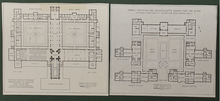Richard Clipston Sturgis
Richard Clipston Sturgis (December 24, 1860 – January 20, 1951), generally known as R. Clipston Sturgis, was an American architect based in Boston, Massachusetts.
R. Clipston Sturgis was the second son of Major Russell Sturgis and his 1st wife, Susan Welles Sturgis, and the nephew of architect John Hubbard Sturgis and successor to his practice. J.H. Sturgis had designed brother Russell's summer house, "Sunny Waters," in 1862, and after the death of J.H. in 1888, R. Clipston designed a summer house, "Rookwood," for his uncle's widow, Frances Codman Sturgis. Both houses are in Manchester-by-the-Sea, Massachusetts.
Sturgis was asked to design Perkins School for the Blind's campus when third director of the school Edward Allen found its current home in Watertown, Massachusetts. Sturgis chose the popular style of the time called English Collegiate Gothic when designing the campus. Allen required Sturgis to incorporate a "family-style" cottage system implemented by Samuel Gridley Howe. This cottage system was meant to replicate the idea of a family setting and help teach student independent living skills (Activities of Daily Life). This cottage style included students of all ages living together in a family like unit with "four teachers, a cook, and a household assistant oversaw 20 students in each cottage[2]". While the structure of cottage style living has somewhat changed from its first implementation at the school, this cottage style of living still exists at Perkins.
Sturgis also considered the unique mobility needs of students with visual impairments and designed the building to reflect this.
- He used many right angles to help with orientation. Right angles help students more easily understand cardinal direction at any given time.[2]
- Equidistant corridors Each side of the building mirrors the other meaning the student can cognitively map one side of the building and then because of their mirroring know the other side of the building as well.
- Stairs on the sides of corridors To help predictability of where a student can find stairs.
- Sightly tilted walkways To help the student understand if their straight line of travel has been affected.
- Animal tiles on columns To serve as a tactile marker of a space aiding in orientation (knowing where one is). Think of it like a sign for someone who is visually impaired- braille was not used at Perkins at this time)
- Rosettes carved into the wood of the seats in the chapel To again be used as a tactile marker
Sturgis served at various times as President of the Boston Institute of Architects, the American Institute of Architects (1913-1915), and the Society of Arts and Crafts Boston (1917-1920); and as a member of the Boston School Board. His sketchbooks and notebooks are archived in the Boston Athenæum.
His son Richard Clipston Sturgis Jr. was also an architect but died at age 30. His daughter, Dorothy Sturgis Harding, was a graphic designer and known for her bookplate designs. His nephew, Alanson Hall Sturgis, also became an architect and was a successor to R. Clipston's practice.
Selected architectural works
- 1876 - Church of the Advent, Beacon Hill, Boston, Massachusetts (finishing his uncle's work)
- 1899 - "Petersfield" (Italian Style) Estate of Senator John Stewart (J.S.) McLennan (1853-1939) in Westmount (Across the Harbour from Sydney), Nova Scotia, Canada.
- 1900 - The Royal Cape Breton Yacht Club (Shingle Style with Colonial Revival Details), 246 Esplanade, Sydney, Nova Scotia, Canada.
- 1907 - Benjamin Franklin Institute of Technology, Boston, Massachusetts
- 1912 ? - Perkins School for the Blind campus, Watertown, Massachusetts
- 1913 - Robbins Memorial Town Hall, Arlington, Massachusetts
- 1914-17 - Additions to Massachusetts State House
- 1919 - Seaside Village, Bridgeport, Connecticut
- 1922 - Old Federal Reserve Bank, Boston, Massachusetts (now a luxury hotel)
- 1935 - Washington Irving District School, (now Washington Irving Middle School) Roslindale, Massachusetts
- ? - Wilmot Apartments Historic District, Bridgeport, Connecticut
Sturgis also designed the Rensselaer Polytechnic Institute seal.
References
- Built in Boston: City and Suburb 1800-1950, Boston: New York Graphic Society, 1978
